10 Topics to learn about Show Jumping – Part I
By: Nestor Imberti Posted: 18/01/2021
Show Jumping – Introduction, origin and rules
Among equestrian sports, Show Jumping is one of the most popular disciplines. It is a classic horse riding sport and, at the same time, a great equestrian event in which riders and horses jump over a number of obstacles.
Nestor Imberti, member of our content management team, has written an article that deals with the 10 topics on Show Jumping that we will deliver in 4 parts so that you can immerse yourself in the World of Jumping and broaden your knowledge of this interesting discipline.
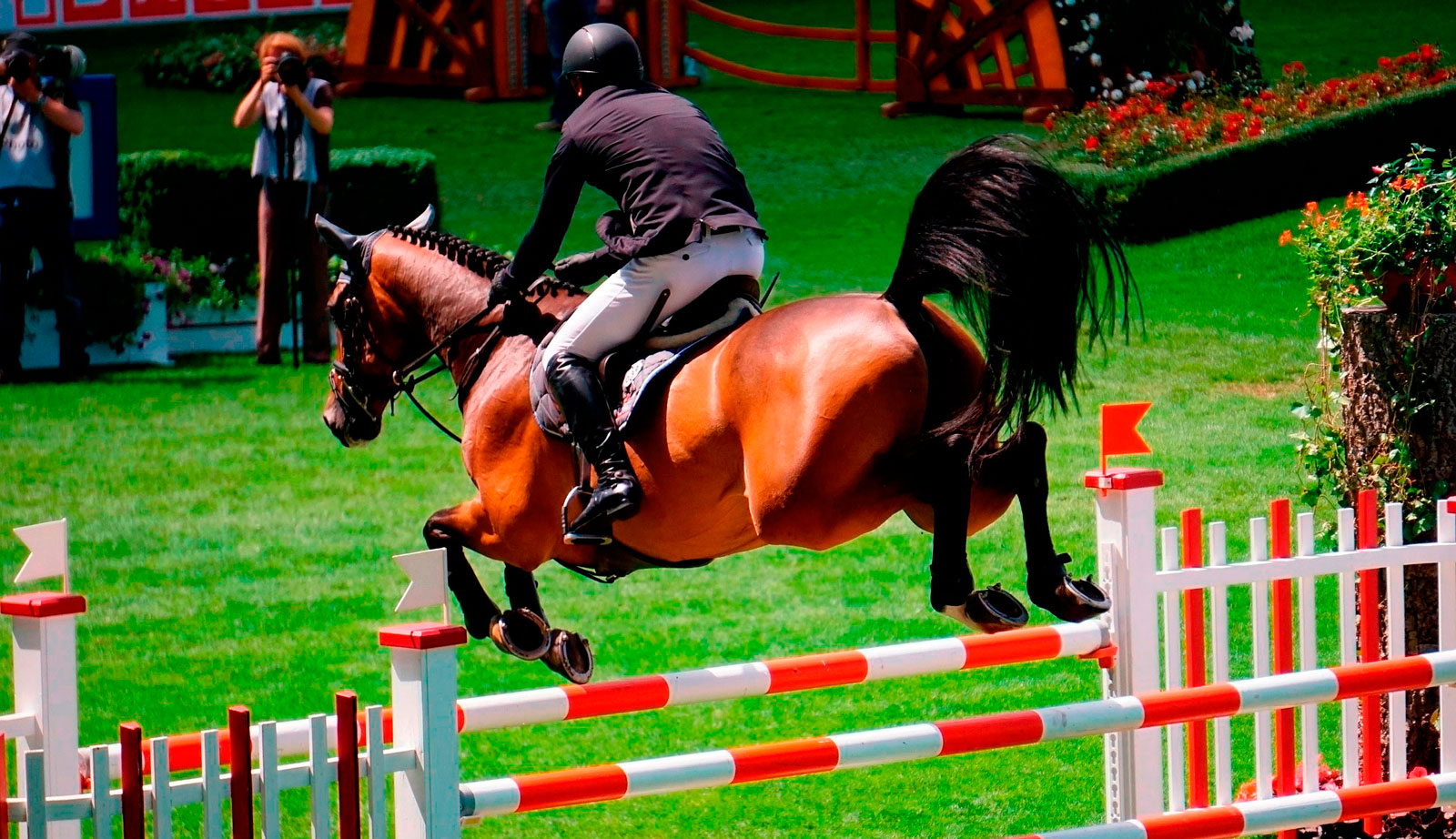
List of Topics in this Article
Part I
- Introduction
- What is Show Jumping?
- Origin and history of Show Jumping
- Show Jumping organization, rules and competitions
Part II
- The main problems that jumping horses can have
- The jumping mechanics of a horse with rider
- How must the rider act during the Jump
Part III
- Introduction to the Principles of Learning Theory
Part IV
- Jumping training based on the Principles of Learning Theory
- Show Jumping and its benefits for the rider
In this first part, we will introduce you to the topic. Then, we will give a definition of this sport. After that, we will look into its origin and history, and the basic jumping regulations in official competitions.
INTRODUCTION
In this article, I intend to give information for those people who might be interested in the sport practice of show jumping, and who already have a first horse riding level. I will briefly explain a series of topics that anyone who wants to start out in this equestrian discipline should keep in mind.
Riders with some experience in jumping might be interested in the approaches that I will present here, regarding how to train horses to jump, based on the principles of Learning Theory and Ethology.
I mention this because I have raised horses for more than 25 years and have applied different training methods or forms with all kinds of experts and trainers who had no formal education. Over 12 years ago, I came across the theoretical basis, based on scientific learning principles and Ethology, when a book by Andrew McLean was handed to me. Thanks to that book, I began to apply those principles, and thus I delved into a world of theoretical knowledge developed by many other researchers who shaped and gave meaning to the above-mentioned principles.
This process helped me understand how ignorant of horses I was, and many horse trainers without formal education ignore those facts, too.
I learned the teachings of Andrew McLean and other equine behaviour researchers and put them into practice by breaking in and training our own horses. Based on these principles, I have also taught other people to train more than 50 horses, obtaining from them great emotional stability and lightness in their mouths. This has also allowed our riders to always keep the horse limbs under the stimulus control produced by clear and well-trained cues or aids, of reins and legs.
Although horses can jump over an obstacle naturally, jumping can also be a learned response, a reaction to certain cues given by the rider. In this article, I will therefore discuss the training of the jumping horse based on the principles that I have mentioned, and that are spread at international level, through annual conferences. Such conferences are organized, each year in a different country, by the International Society for Equitation Science (ISES) .
The theoretical sources for horse Jump training that I have used to give this posting a different approach to the subject, come from that book by McLean and many other articles of his own authorship. In addition, I have also based my findings on other scholars of ethology and learning theory in horses.
WHAT IS SHOW JUMPING?
Horse jumping is an equestrian sport where the horse and its rider are perfectly synchronised and attempt to jump through sets of obstacles within a specific time. The obstacles are arranged in a given order and have specific heights, according to the competition categories. All these parameters are set in the regulations approved by the International Federation for Equestrian Sports (FEI, from the body's French name of Fédération Équestre Internationale).
As regards categories, there are a number of different heights at which horse and rider compete at. Riders are also categorised by age.
It is important to note that in this sport, men and women compete on equal terms.
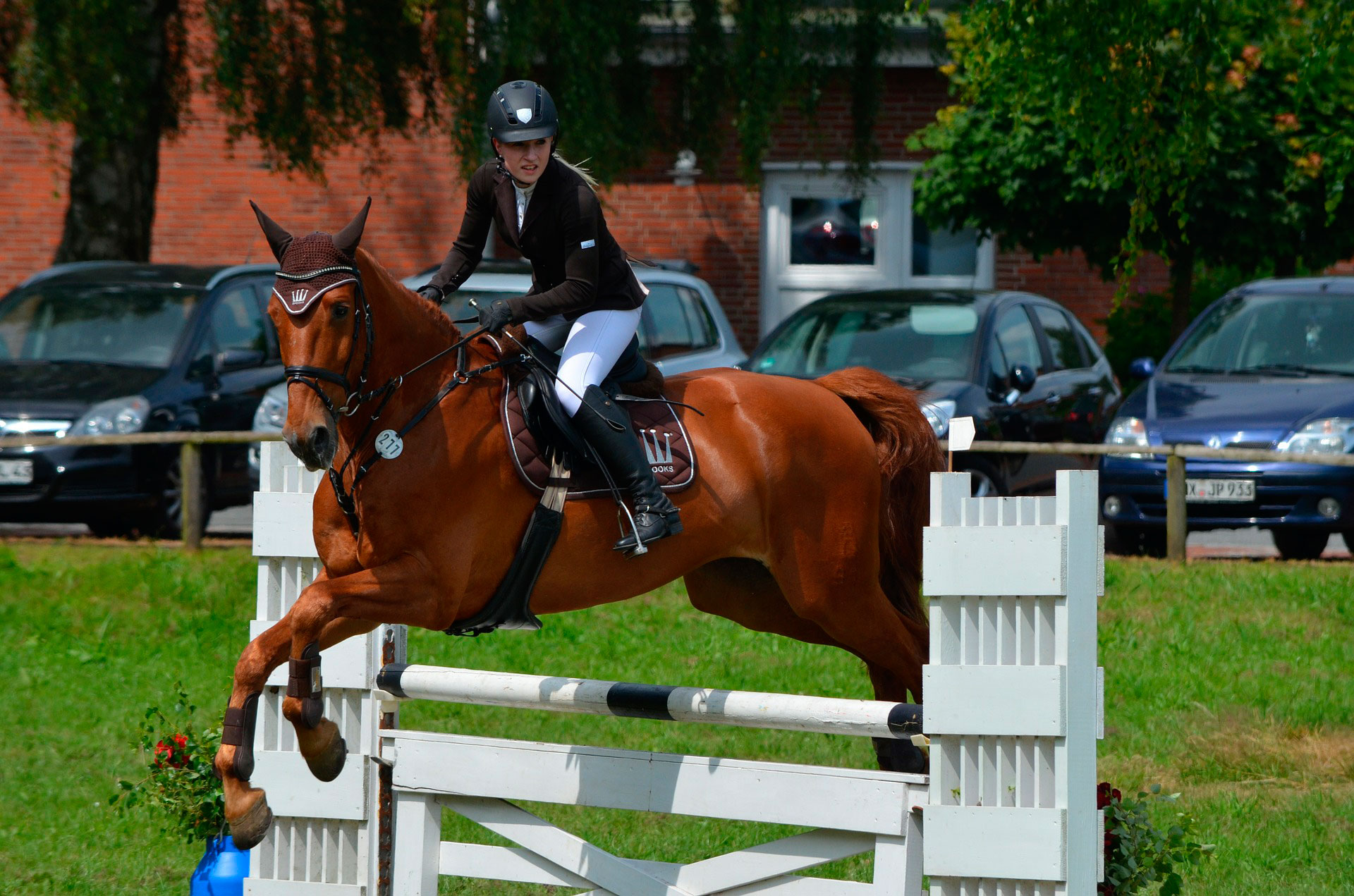
Horses and riders form a pair and both are considered athletes.
In a competition, there are a number of penalty points for the participating rider and they are applied during the competition. The rider who receives the least penalties, is the winner of the contest.
That said, I would like to add that horse jumping is one of the most popular equestrian disciplines, which also allows contact with nature, because it is practiced outdoors, and provides a very attractive spectacle that attracts many enthusiasts, in various parts of the world, especially in Europe.
In addition, Horse Jumping brings great benefits to physical health and also improves concentration to a great extent.
Would you like to be part of a group with an equestrian soul?
Join the Ampascachi Community. Obtain exclusive benefits for your holidays.
We tell you how to start, train and take care of your horse.
Interviews with direct providers of riding tours around the world.
Opinions of outstanding equine scientists and personalities in the equestrian sport world.
ORIGIN AND HISTORY OF SHOW JUMPING
It is often said that its origins date back to the mid-18th century in England, as a part of sport hunting.
The truth is that there are no specific references to the origin of jumping as an equestrian sport, but as we said, it was an essential part of sport hunting.
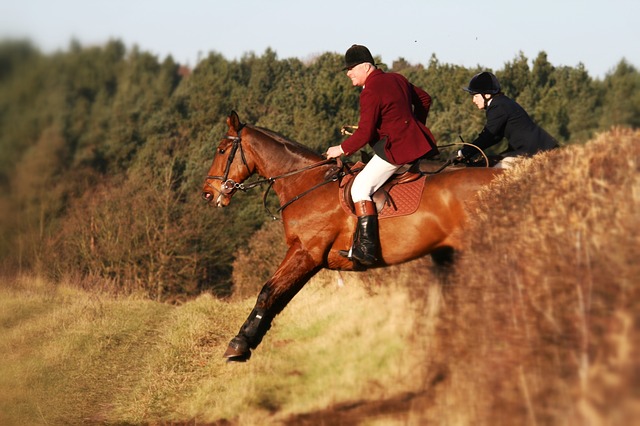
In the 19th century, hunting through fenced fields increased this practice considerably, not only in the United Kingdom, but also in most parts of Europe.
From then on, horse breeds were improved in order to gain greater physical ability to gallop and jump at a faster speed, laying the foundations for what is now modern Horse Jumping.
To practice this activity, the first itineraries included a series of obstacles and riders had to jump over them as fast as possible. Such obstacles consisted of fences and courses or ditches with water and mounds of earth. That is to say, they formed this obstacle course and riders had to jump over them.
Since spectators could not follow to watch these obstacle competitions because they were held across the country, it was not long before fences began to appear in an arena for the competitions. It was then that this sport began to be more popular than sport hunting.
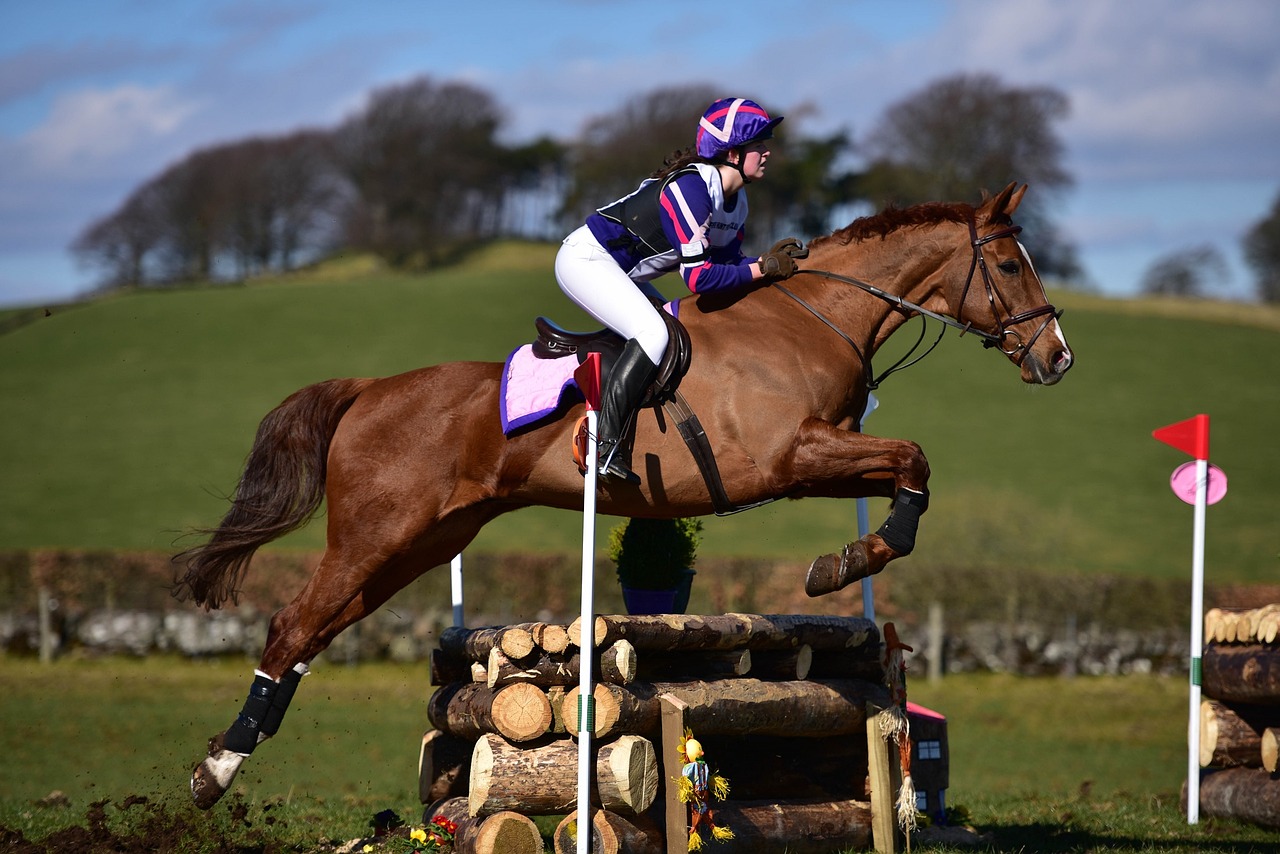
This kind of competitions in enclosed arenas became known as “lepping”. According to some authors, in 1865, the first lepping or horse leaping competition took place at Dublin Horse Show, in Ireland.
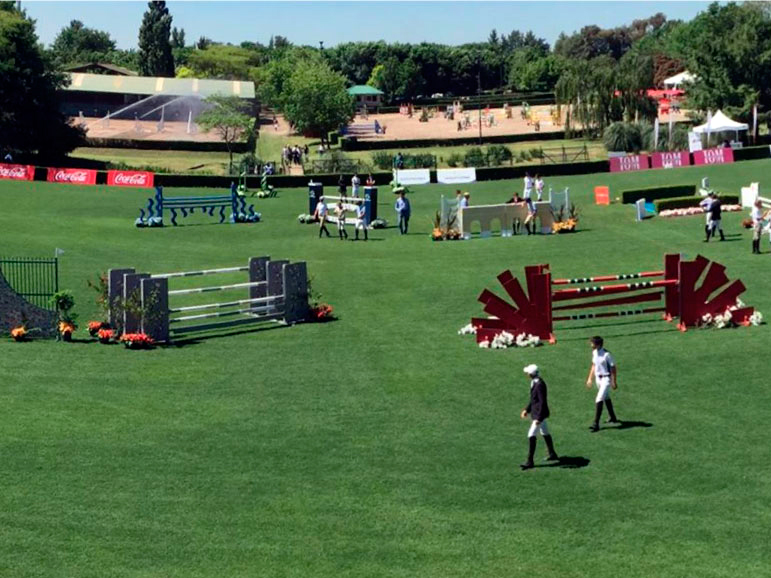
From then on, since this type of competitions started to win followers quickly, an early form of show jumping was incorporated into the Olympic Games held in Paris in 1900.
Nevertheless, it was not until 1912 that Show Jumping was included in the Stockholm Olympics.
Who was the rider that shaped and promoted Modern Jumping?
As we said, riders originally jumped over fences across the fields during the hunts. Then, there were cross-country obstacle races and this new discipline was even included in the 1900 Olympic Games. However, riders jumped without having developed a proper technique; they did so keeping the body rigid and did not accompany the movement of the horse's body.
It was then that an Italian cavalry officer, named Federico Caprili, introduced the forward-seat, a riding style that relieved the back of the horse. This style placed the rider in a position that did not interfere with the balance of the horse while negotiating obstacles. He promoted the use of shorter stirrups and long reins, improved the saddle and many other things that led him to produce ever higher jumps until reaching the first world record of 2.08 meters. Today, he is considered "the mentor of modern horse riding."

Federico Caprilli jumping
Finally, we will say that by 1921, the "International Federation for Equestrian Sports" was founded. This organization standardised the regulations of the equestrian disciplines and the various international official competitions, including the World Equestrian Games and the Olympic Games.
Until 1952, only commissioned military officers were permitted to compete in equestrian disciplines and, in 1956, women were allowed to participate in the Olympic Games.
SHOW JUMPING ORGANIZATION, RULES AND COMPETITIONS
This discipline is organized in each country by a national organization that can determine different competition regulations and modalities, but the International Federation for Equestrian Sports (FEI) is the body that sets the regulations for official international competitions, including the Olympic Games and the World Equestrian Games. The FEI is also responsible for establishing the High Jump and Long Jump world records.
What are modern events like?
In a show jumping event, the participating pair (rider and horse) must complete a course of 10 - 13 jumps over certain obstacles, which are numbered. The objective is to test both horse and rider on their skill, accuracy and training, by presenting them with a challenging course of obstacles to jump.
During the course, the pair must jump the obstacles, in a predetermined sequence and trying not to make mistakes. Faults are determined and penalized with points that are assigned to each type of fault, and these points are cumulative during the competition.
The winning pair is the one that completes the obstacle course with the lowest penalty score and in the shortest possible time.
It should also be noted that there are events where time limits are set to the course and if these limits are exceeded, there are also penalties.
What are the types of penalties?
The penalties are of different types or characteristics. We will list those types with a brief description, without going into more details about them and we will give the score that is usually awarded, in general, to them. We will also indicate which penalties imply disqualification or withdrawal from the competition, for the participating pair.
Types of penalties:
- For knockdowns of an obstacle, when any of the horse's feet touch the water or white tape marking its boundary. If a rail is set over the middle of the water, faults are not accumulated for landing in the water. Penalty of 4 points.
-
For disobedience, penalty of 4 points. There are three scenarios:
- Refusal: the horse refuses to jump.
- Run-out: the horse cannot be controlled by the rider and avoids jumping.
- Circle: the horse stops without a reason, or turns a circle or several circles in front of the fence, or starts to buck or goes backwards without a reason.
-
For faults during the competition. This is the case when the pair:
- Does not follow the sequence established for the competition.
- Does not jump the fences in the right sequence or from the right direction, except for some particular events.
- Does not cross the start or the finish line between the flags, in the right direction.
- Omits the compulsory steps.
- Jumps or tries to jump a fence that is not included in the course, or forgets to jump a fence
-
For fall of horse / rider. A fall of rider is when he/she:
- Touches the ground.
- Needs external assistance or help (of any type) to go back to the saddle.
This type of error is penalized with elimination. - For forbidden unofficial assistance. The assistance from an external third party. This type of error is penalized with the elimination of the pair.
- Exceeding the specified time limit. It is penalized with the elimination of the pair.
These penalties are those established in Table A, which is used in most competitions.
There are other events that observe the penalties of another table, the so-called Table C that is intended for testing speed, where only time matters.
In such events, faults are converted to penalty seconds that are then added to the total time of the pair in the course of the track.
In the two types of tables, there are specific time limits that cannot be exceeded and the pairs that pass those time limits are penalized with 1 point for each second they exceed.
Subscribe to the Ampascachi Community and obtain benefits and exclusive content. Furthermore, we offer free advice on horses and equestrian tourism.
What are the different types of competition?
Progressive Difficulty
This event is contested over six, eight or ten types of obstacles, which progressively become more difficult.
The obstacles cannot be combined.
The difficulty lies not only in the height and depth the obstacles, but also in the course provided.
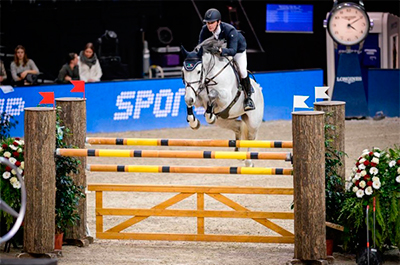
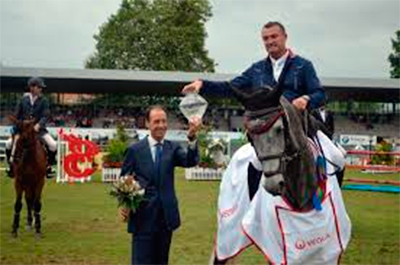
Derby
This event is developed for a minimum distance of 1,000 and a maximum of 1,300 meters, on a course where at least half of the jumps are over natural obstacles and there is only one jump-off, if expected.
The event is not timed, but there is a time limit.

Doubles and Triples
In this event, there must be six obstacles: the first one is simple and the other five are combinations with one triple obstacle, at least.
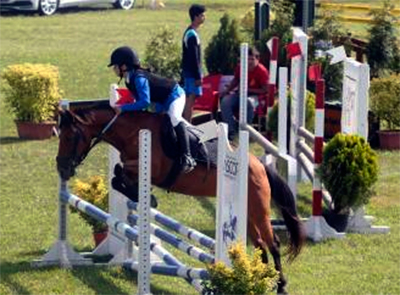
If there is a jump-off indicated in the advance, the course must comprise six obstacles: a double, a triple and four simple obstacles or three doubles and three simple ones.
Those types of combinations used in the initial course must be eliminated.
Puissance
The objective of this event is to test the horse's ability to jump few obstacles of large dimensions.
It includes a maximum of five rounds, one for the opening followed by a maximum of four jump-offs, with no specific time for each intervention.
In the first round, there are four to six individual large obstacles, including the puissance wall.

The first obstacle must be at least 1.40 m high, two obstacles between 1.50 m and 1.60 m and a wall or vertical obstacle that can be 1.60 m or 1.70 m high. All combinations of fences, water holes, ditches and natural obstacles are prohibited.
For jump-offs, only two obstacles are placed, a horizontal or a vertical one and the puissance wall. Vertical obstacles should be raised and horizontal obstacles widened at each round, if participants who have evened the score for the first place have not been penalized on the previous course.
When horses are equal first after the fifth round, competitors share the grand prix.
Regarding the puissance wall, we will say that the current world record in this competition is 2.4 m.
The popularity of these power events has been decreasing in equestrian contests because they are considered very dangerous to the horse, in case of an accident. This is why this event has evolved into the six-bar competition.
Six-bar
In this event, horses must jump six vertical fences set in a straight line. In most places, fences are placed at equal distances apart, approximately 11 m.
Fences must be formed identically using only bars of the same type.
If the size of the arena does not allow the six fences to be placed in a single line, the event can have less fences.

Fences can all be placed at the same height or you can opt for heights that increase progressively, either one at a time or two by two.
In case of run-outs, the competitor must resume the course at the obstacle where the fault was incurred.
The first jump-off takes place with the six obstacles that have previously been progressively raised, except in the case where the participants who have evened the score for the first place have been penalized on the initial course.
After the first jump-off, the number of fences can be reduced to three or four. The lowest ones must be removed and the distance between them must be kept (11 m, as we said) for the first course.
If there are multiple jump-offs, the height of the fences in the final rounds can be raised to more than 1.80 m.
Show Hunters
Show hunters aim to test the obedience, performance and speed of the horse throughout winding courses that have different fences. These are real Speed Competitions.
Show hunters, ideally, show many qualities that were rewarded in the fox hunting field. Different fences are used and they must simulate those found in the hunting field such as natural post and rail, brush, stone wall, white board fence or gate.
These competitions allow for alternative obstacles, which give the competitor the possibility to shorten their course, but in exchange for jumping a more difficult obstacle.
There are no fixed orders to follow, but a set of arrows must be placed to indicate the direction in which each obstacle should be jumped.
High Jump
This competition consists of a single fence that the participating pair must jump.
It starts from a minimum height of 1.60 meters and the difference with all the other competitions is that there is only one single jump.
The High Jump competition has a set of regulations that test both the shape and arrangement of the vertical obstacle, which consists of a slightly sloping fence.
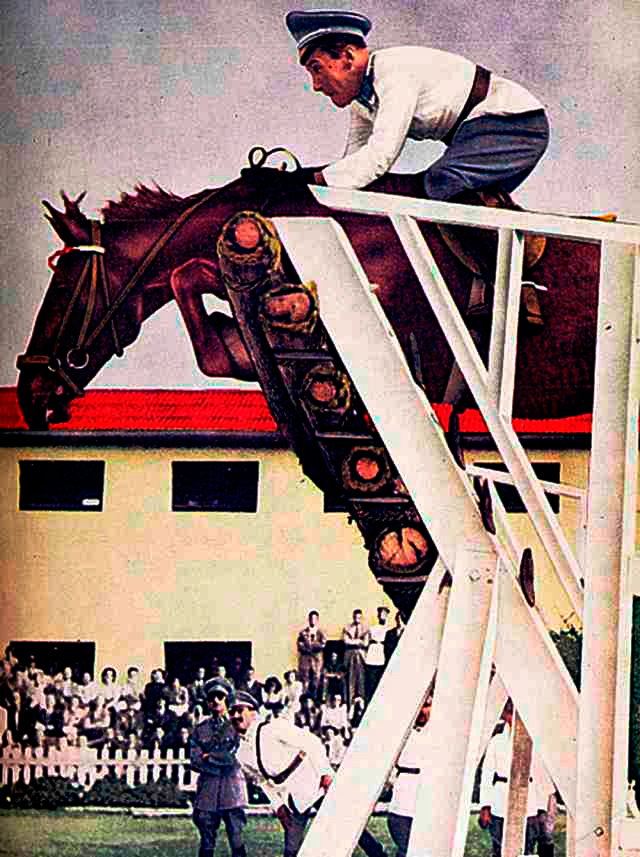
Huaso high jump world record
The above-mentioned Italian officer, Federico Caprilli, and his horse Melapo, set the first record when they jumped 2.08 meters in 1902.
In 1949, a new record was achieved by a Chilean army officer, Alberto Larraguibel, with his horse Huaso. This new high jump record stands at 2.47 m and it has not been broken up to now.

Huaso in 1944 high jump world record
Long Jump
In this competition, the pair must jump a single obstacle of a given length in the horizontal plane. The test consists of a joint jump over a low fence and a water hole. The distance between the fence and the water is gradually increased, and the winner of the competition will be the one that jumps the longest length, without penalties, whatever penalties he received in previous attempts.
There are penalties for touching the water or the white tape marking its boundary. Refusals, run-outs and circles are also penalized.
The participating pairs can make only three long jump attempts and if they do not succeed, they must withdraw from the competition.
The construction of the long jump obstacle must meet a number of requirements that are stipulated in the regulations set by the national equestrian federations and the FEI.

Cross Country
It is considered an equestrian discipline in itself, but we mention it here because one of the most important characteristics of this discipline is obstacle jumping, apart from the speed that the horses must develop. Actually, it is an obstacle race, which somehow gave rise to the equestrian discipline of modern Jumping.

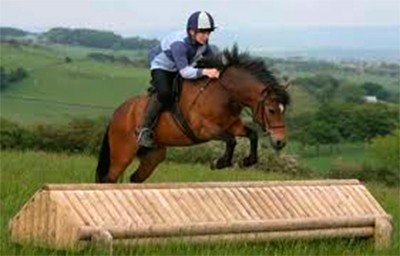
Cross Country together with Dressage and Show Jumping are the three disciplines comprised in a horse trial called Eventing.
The aim of the event is to test the speed, endurance and jumping ability of the cross-country horse, when it is well trained and at the top of its condition.
It also tests the rider's ability to control the various gaits in which a horse moves.
In this event, the fences attempt to mimic the natural obstacles you would see when riding across the countryside, such as hedges, walls or water. These are solid, which means they don't fall off if we bump into them.
Depending on the course and the chosen field, riders sometimes have to jump obstacles down or uphill,
Some issues to consider in the competitions
Rider attire
Riders must wear a formal attire and a helmet. In addition, their whip could not exceed 75 cm and, in international competitions, riders and their saddles must not weigh less than 75 kg, whether male or female, and they are weighed before the competition.

Boots

Formal attire and helmet
The Jumping Arena
The arena must be closed on all sides and have a minimum area of 2,500 m2. In general, it has between 10 and 13 obstacles that can be moved and they have varied shapes, such as walls, fences, doors or bars.
The 5 types of obstacles
- Vertical: it consists of poles or planks placed one directly above another.
- Oxer: two verticals close together, to make the jump wider.
- Wall: this type of jump is usually made to resemble a brick or stone wall.
- Combination: usually two or three jumps in a row, with no more than two strides between each.
- Open water: a wide jump over water. Generally, a small fence is placed on the edge, and the horse must set its feet after the mark where the pool ends.
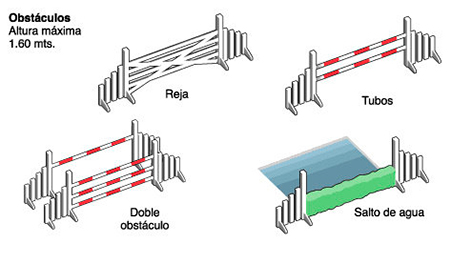
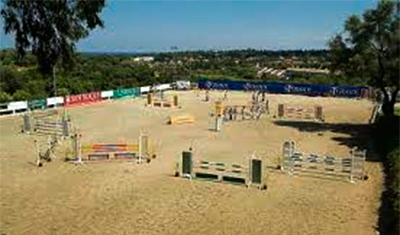
The way obstacles are placed in the arena varies according to the course or level of competition.
However, in all cases the length to be covered from the point of departure to the point of arrival, should not exceed the number of obstacles multiplied by 60, expressed in meters.
Besides, there must be a distance ranging from 6 to 15 m between the starting point and the first obstacle; and between the point of arrival and the last obstacle, there must be around 15 to 25 meters.
All riders have the right to visit the arena to study the most convenient way to move and they can inspect the floor, before the competition.
The most important international competitions
- The Olympic Games are held every 4 years. The next ones will be in Tokyo in August 2020 (postponed until 2021).
- The World Equestrian Games (WEG) are held every 4 years. The next games will be in 2022 and will be held in two places: Denmark and Italy.
- The FEI World Cup Jumping Series consist of competitions held in different riding centres from October to April. The best riders of the FEI rankings can participate. The series end with an annual final competition.
- Nations Cup and Super Leagues: the Nations Cup is the oldest and most prestigious team competition in the world. It was first held in 1909, when a team competition for officers took place in London. There are no individual prizes in this competition.
To increase media and viewer interest, in May 2003 a new partner entered the Series. A Super League, where the top 8 countries compete in 8 very important events.
This was received with great enthusiasm by riders and it has brought a lot of excitement because between the Nations Cup and the Super Leagues a new system was created. Thus, the top 8 nations go on to compete in the Super Leagues the following year and those nations that are not among the top 8 remain in the Nations Cup.
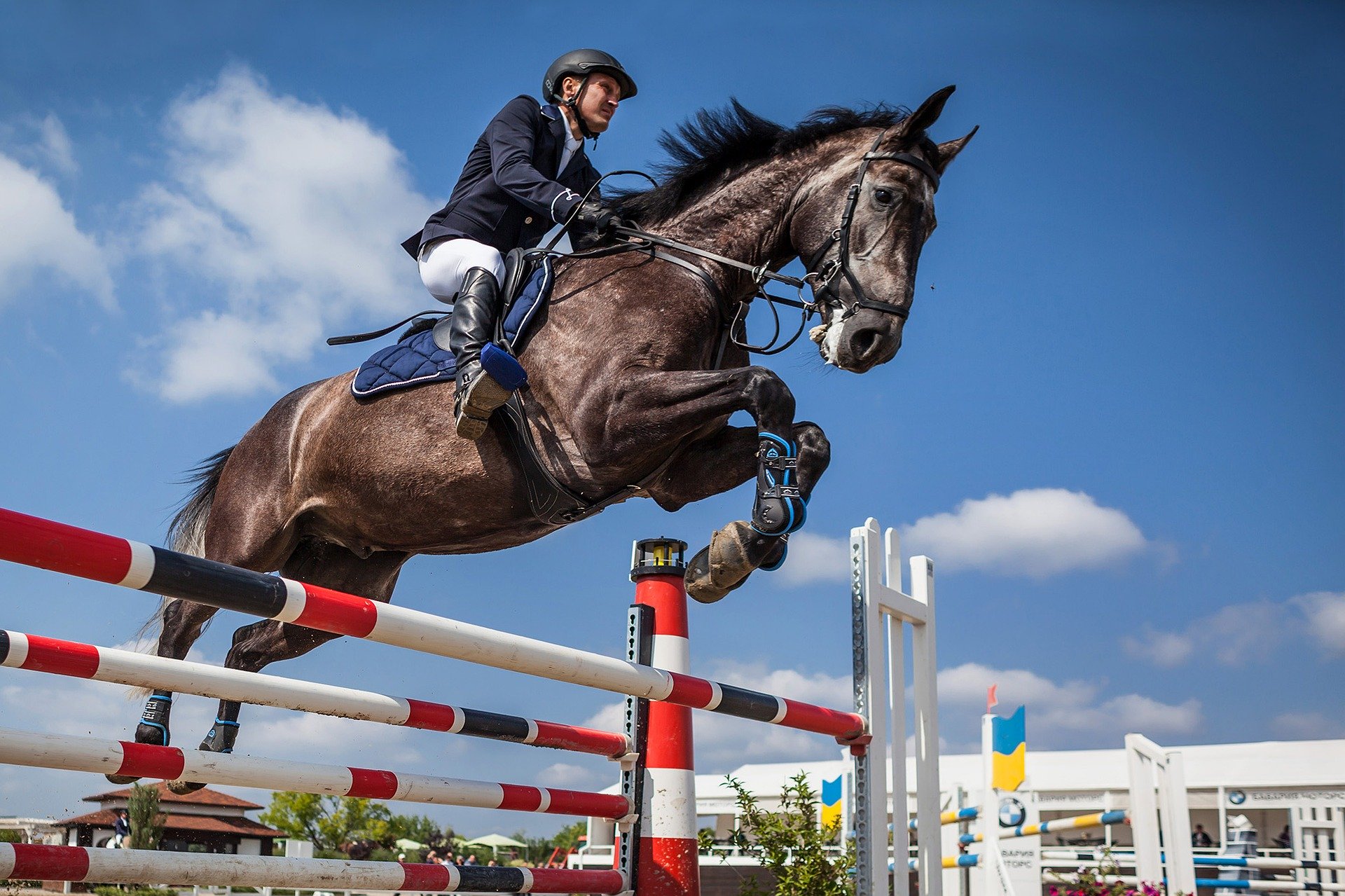
Here we close the first part of the Show Jumping series. We hope that you have enjoyed this introduction and that you are interested in reading the next chapter of this article.
If you have questions or personal experiences in Show Jumping, share them with us!
Would you like to delve deeper into the world of horse training?
Download our free guide on Horse training step by step. There we tell you everything we have learned about horse training in more than 25 years of experience.
And if you want to be a professional horse trainer and get field-based training, you should check out our training program. You will have the opportunity to live in our equestrian centre and experience our full training process with young horses.
~
THIS COULD ALSO BE INTERESTING
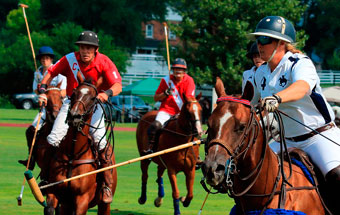
Equestrian sports & games: Polo
Do you know the rules of Polo, the oldest of equestrian sports that was played by nomadic warriors of Central Asia? Polo is becoming considerably popular nowadays.

Horse training: Interview with Andrew McLean
Dr Andrew McLean is one of the persons that have had mayor influence in the world of equitation with his books and investigations on the learning behaviour of horses.
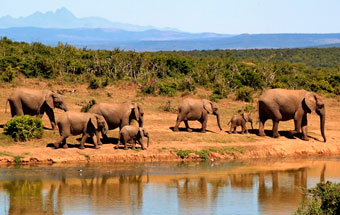
Horse riding holidays in South Africa
One of the main countries in Africa where you can go horse riding is South Africa. It is an exotic destination for a horse riding holiday, suitable for all kinds of thrill seekers.
~
WHAT IS YOUR OPINION? LEAVE A COMMENT
Your comments
I'd like you to explain the types of jumps with a photo or drawing next to each jump to understand it better. Thanks a lot!
I think that information was great! Congratulations!! Jumping is so nice.
Nice ! Thanks For Sharing Valuable Information.
Planning your horse riding holidays?
Join the Ampascachi Community. You will get exclusive advantages and guidance for your next horse riding holiday.


 German
German French
French Spanish
Spanish